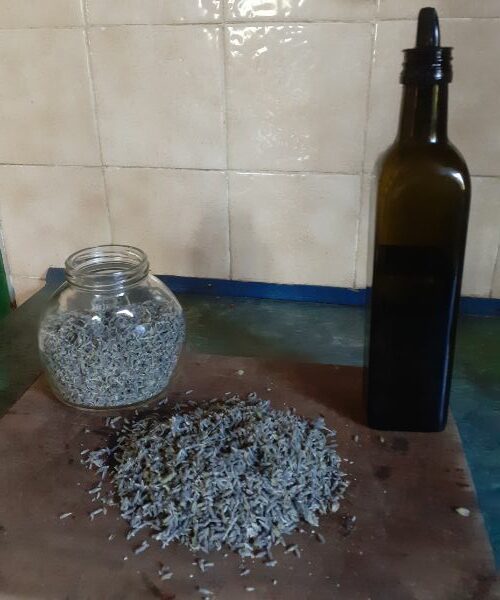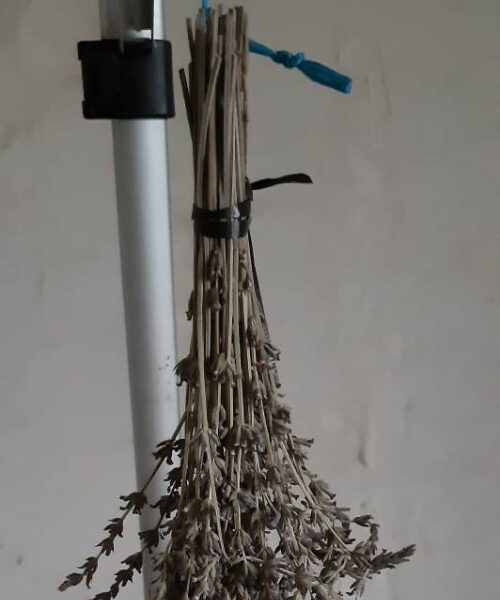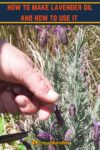Lavender is widely used to treat mood disorders and insomnia but has many benefits when used topically.
Lavender has antibacterial, antifungal, and anti-inflammatory properties, which make it highly effective against various skin conditions and irritations. It reduces pain, helps combat fungal infections, and promotes wound healing.
You can also use lavender oil to prevent and soothe acne outbreaks and treat skin conditions like eczema.
Although essential oils are more potent than infusions, you need an enormous amount of lavender flowers to make a tiny quantity of essential oil. On the other hand, a lavender oil infusion has a much higher yield and a wide range of external uses.
A Simple Method for Making Lavender Oil
There are around 450 different varieties of lavender, some of which are more highly regarded for their medicinal properties than others.
For this tutorial, I harvested Spanish lavender but used dried English lavender to make the oil.
Although Spanish lavender is a popular traditional remedy used internally to treat asthma, headaches, and flu symptoms, English lavender is the preferred medicinal variety.

The best time to harvest lavender flowers is in early spring, just as they bloom. It’s also better to harvest lavender early in the day before the sun draws out too much of its fragrant essential oils.
Once harvested, the flowers must be thoroughly dried. Any moisture in the lavender could cause mold to form, spoiling the oil. Drying the flowers will also maximize the essential oil content of the oil.
Step One: Getting Started

You need the following ingredients to make a lavender oil infusion:
- Dried lavender leaves or flowers
- Oil – there are around 11 different carrier oils that are suitable for making lavender-infused oil. If you want to use your lavender oil to prevent acne, high-quality, unrefined grapeseed oil is the most effective as it is non-comedogenic and, therefore, less likely to clog your pores. Other options include jojoba oil, coconut oil, sweet almond oil, and olive oil.
- A clean glass jar with an airtight lid
- A pot of water
- Labels
Step Two: Harvest and Dry the Lavender
You can either harvest just the lavender flowers by pinching them with your fingertips or branches of your lavender plant by snipping them off with a pair of secateurs.

It’s easier to dry lavender harvested in bunches as you can hang it in a dark, warm spot more effectively than the individual flowers. However, if you have a dehydrator or solar dryer, you can lay the flowers out on the shelves provided.

Assuming you have dry, warm weather, your lavender flowers should be completely dry in seven to 10 days, at which point you move on to the next step.
Step Three: Prepare the Oil and Container
Select a clean jar with an airtight lid and sterilize it with boiling water before use.

Fill the jar with dried lavender flowers until it’s half to three-quarters full.

Pour your oil of choice into the jar until it covers the flowers completely.

Select a heavy-based saucepan or pot and place a plate or bowl at the bottom to prevent the oil and flowers from getting too hot.
Half-fill a pot with water and bring to a boil.
Place your sealed glass jar into the saucepan and turn the heat off. Leave the jar and its contents in the water to warm gently for approximately five minutes. This process helps to extract the flowers’ essential oils and release them into the oil.
Remove the jar from the saucepan and allow it to cool.
Shake the jar to agitate the mixture further and stimulate the release of the essential oils.
Label the jar, noting the type of herb inside and the date it was made.

Step Four: The Finishing Touches
Leave the jar in a warm place for three to four weeks.
Once your oil is ready, strain it into a fresh, clean jar using cheesecloth. If you don’t have any cheesecloth available, you can use recycled net curtains, provided they are washed thoroughly first.
Squeeze the herbs inside the cloth or net to extract the last drops of oil. Discard the lavender flowers.
Your oil is now ready to use. You can also transfer the oil into smaller containers or bottles for later use.
Lavender Oil Uses and Benefits
The lavender-infused oil is suitable for external use only, but it has a range of benefits and uses that survivalists and campers will be grateful for.
#1 Alleviates Insomnia, Stress, and Anxiety
Lavender has a delicious, soothing aroma that, when inhaled, helps to reduce depression, anxiety, stress, and insomnia. I wished I’d taken some along on my last camping trip when a combination of factors saw me grabbing just four hours of sleep a night.
Rub a little lavender oil into your feet before you snuggle into your sleeping bag, and you’ll have a more comfortable and beneficial night’s sleep. A study published in 2015 found that lavender not only improves sleep quality but also leaves you feeling more refreshed when you wake up.
#2 Repels Insects
In addition to making your tent smell nice, lavender oil is an excellent natural insect repellent. Rubbing onto the skin will help keep mosquitos and flies at bay, especially if you focus on the so-called “hot spots” behind the ears and neck and under your arms.
Never use essential oil directly on the skin, as it is too powerful and could cause irritation.
#3 Relieves Pain
Lavender has potent anti-inflammatory and analgesic properties, making it an effective pain reliever. Apply it directly to sore muscles or joints to relieve pain and inflammation, and improve blood circulation.
You can also inhale lavender oil to reduce the pain of headaches and prevent the onset of migraines. When used as an aromatherapy massage oil, it can also reduce the pain and discomfort associated with menstrual cramps.
#4 Reduces Skin Irritations
Applied topically, lavender-infused oil reduces the itchiness associated with insect bites, stings, and allergic reactions. It also soothes rashes and reduces the pain of sunburnt skin. Lavender oil also treats skin conditions such as eczema and psoriasis.
#5 Promotes Wound Healing
Lavender oil can be applied topically to scratches, scrapes, and cuts to stimulate and accelerate healing. Research shows that “wound closure progressed more rapidly with topical application of lavender oil,” reducing the risk of infection. Lavender oil also reduces scarring by promoting cell and tissue growth.
#6 Alleviates Asthma and Other Respiratory Problems
Studies show that inhaling lavender oil may help “suppress inflammation of mucous in the respiratory system,” which can reduce the symptoms of bronchial asthma and other respiratory issues, including Chronic Obstructive Pulmonary Disease (COPD).
#7 Prevents Acne
Being antibacterial, lavender oil has proved effective against acne. It helps to unclog the pores and kill the bacteria associated with acne breakouts. It also reduces inflammation, alleviating some of the pain associated with acne.
#8 Soothes Cold Sores and Sun Blisters
Apply lavender oil directly onto cold sores and sun blisters to help soothe and promote healing.
#9 Acts As a Natural Cleaning Product
Lavender oil’s antibacterial qualities make it an effective surface cleaner and fighter of germs. You can use it to disinfect your camp kitchen and cooking utensils.
With its antibacterial and deodorizing qualities, lavender oil is useful for keeping your camping equipment clean, especially when combined with vinegar, a natural disinfectant.
How To Use Lavender Oil
Inhale lavender oil to reduce anxiety and stress, improve sleep quality, and alleviate the symptoms of bronchial asthma and COPF. To do this, you can either inhale it straight from the bottle or apply it to your top lip.
Applied topically, it reduces joint and muscle pain and stimulates wound healing.
When used in an aromatherapy massage, lavender oil can reduce menstrual pain and cramps.
Massage lavender oil into your face after washing to prevent acne outbreaks and stimulate healing.
Add a few drops of lavender-infused oil to a combination of water and vinegar, and then use a cloth to disinfect surfaces.
Possible Side Effects of Using Lavender Oil
Essential lavender oil is highly potent and should never be applied directly to the skin. Doing so can cause irritation and allergic reactions. Lavender-infused oil is much milder and, therefore, safer to use topically, although some people may still experience adverse symptoms.
The lavender-infused oil is generally safe when taken internally, but it’s not recommended. Taken in high dosages, lavender oils of all types can cause nausea, vomiting, breathing difficulties, and stomach pains.
What Makes Lavender Oil so Effective?
Lavender contains some potent essential oils, terpenes, and phytochemicals, including linalool, camphor, and linalyl acetate.
Lavender’s cleansing and insect-repellent properties come from the high content of linalool, which is also responsible for its calming effects. The presence of camphor makes lavender effective in the treatment of skin conditions and gives it its pain-relieving powers.
Conclusion
If lavender oil isn’t already on your survival first aid kit checklist, it’s probably time you added it. With so many uses, it can significantly reduce the number of medical supplies you need to carry.
If you’ve got lavender-infused oil, you don’t need to carry separate insect repellents, anti-inflammatories, painkillers, and sleeping pills. It’s like having a complete first aid kit in a single bottle. Better still, it’s completely natural, so it won’t negatively impact the environment.


